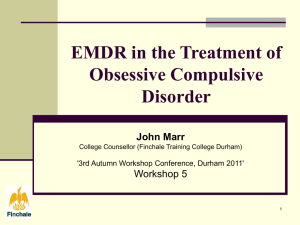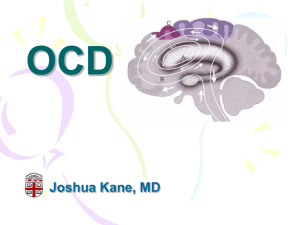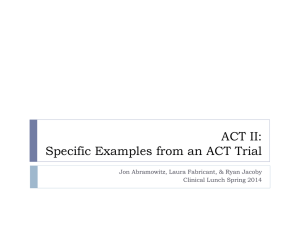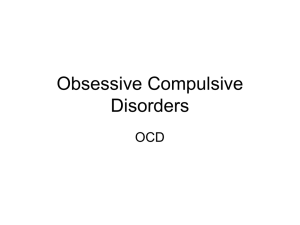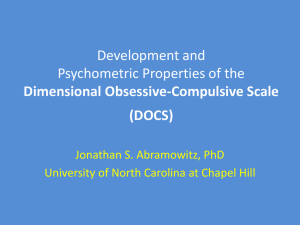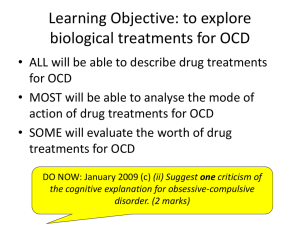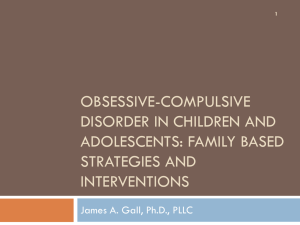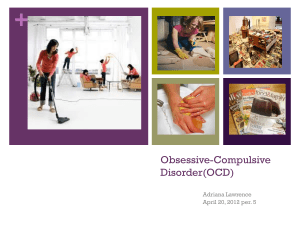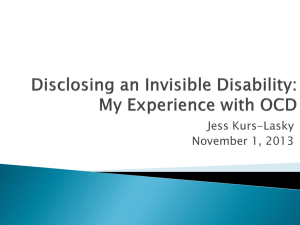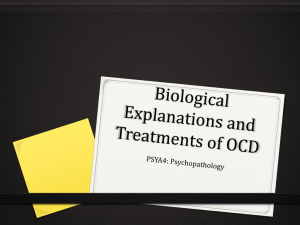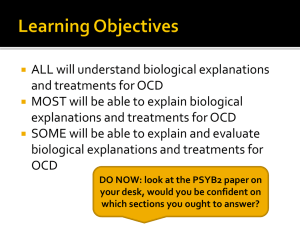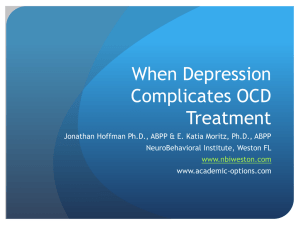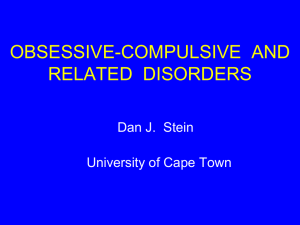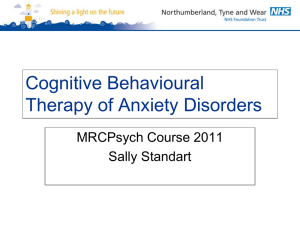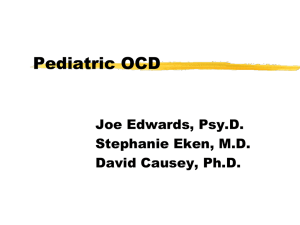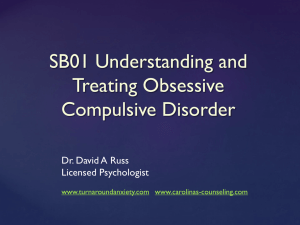Obsessive Compulsive Disorder
advertisement
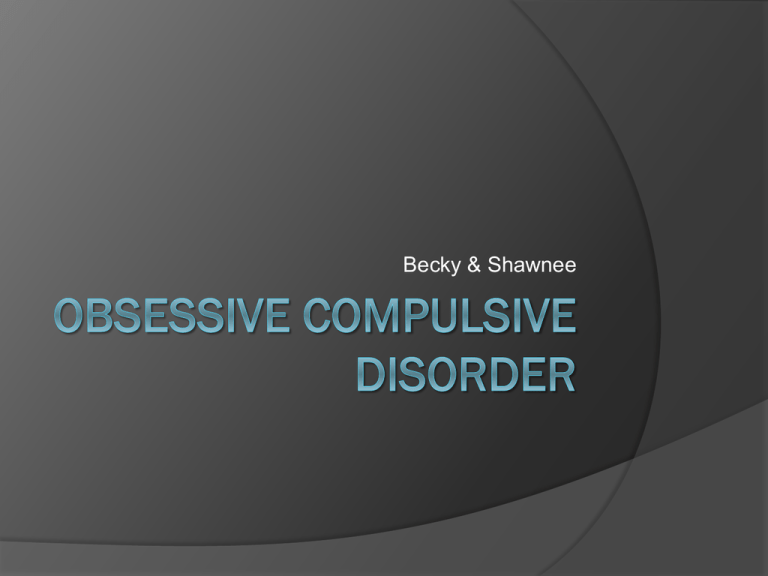
Becky & Shawnee What is OCD? Is an anxiety disorder that effects 1-2% of the population They experience obsessions and compulsions Obsessions – unwanted thoughts, images or impulses that cause a lot of stress and anxiety Compulsions – are behaviours or acts that are carried out to reduce the anxiety What is OCD? OCD can be different from person to person Some cases of OCD can not be treated as well as others OCD affects every part of a person's life Can occur at any age but often before the age of 40 Causes of OCD Behavioural Theory - Suggests that people with OCD associate certain objects or situations with fear, and that they learn to avoid the things they fear or to perform rituals that help reduce the fear Cognitive Theory - The cognitive theory focuses on how people with OCD misinterpret their thoughts and feelings Causes of OCD Genetics Often runs in the family (half of the recorded cases show this pattern) Research studies report that parents, siblings and children of a person with OCD have a greater chance of developing OCD than someone with no family history of the disorder. A commonly asked question is if OCD can be learned by another person Researchers have looked for certain genes that may be linked to OCD, but have not been able to find any It is believed, however there may be genes that are involved in regulating serotonin, and passed on through the generations. Causes of OCD Serotonin Research have revealed a link between OCD and insufficient levels of a brain chemical called serotonin. Serotonin is one of the brain's chemical messengers that transmit signals between the brain cells. Serotonin plays a role in the regulation of mood, aggression, impulse control, sleep, appetite, body temperature and pain. All of the medications used to treat OCD raise the levels of serotonin available to transmit messages. Symptoms Obsessions Contamination Repeated Doubting Ordering Religious Aggressive Sexual Compulsions Cleaning/Washing Checking Arranging/Ordering Hoarding Exposure and Response Prevention (ERP) The most widely practised behaviour therapy for OCD is called exposure and response prevention There are two components: Exposure Treatment Response Prevention Treatment Treatment starts with exposure to situations that cause the least anxiety As the patient overcomes these, they move on to situations that cause more anxiety ERP Exposure Treatment Controlled exposure (direct or imagined) to objects or situations that trigger obsessions while raising anxiety levels Over time the exposure leads to less anxiety and over a long period of time it leads to very little anxiety at all ERP Response Prevention Treatment The ritual behaviours that people with OCD engage in to reduce anxiety Patients learn to resist the compulsion to perform rituals and are eventually able to stop engaging in these behaviours Serotonin Reuptake Inhibitors SRI Type of antidepressant Main function is to increase levels of serotonin in the brain Take one a day Doses can change as time goes on Over time, OCD becomes less intense and happens less often SRI SRIs won’t always work for everyone Not uncommon for someone to try 2 or 3 SRI drugs before finding one that works best Most people try at least 3 SRI drugs before considering other types of medication Other Medications Monoamine Oxidase Inhibitors The monoamine oxidase inhibitors (MAOIs) are effective antidepressants The two MAOIs available are phenelzine (Nardil) and tranylcipramine (Parnate). Both are less effective against obsession than SRI’s, and both have more complicated side-effects The MAOIs are used to treat OCD only when SRI medications fail Recovery Therapy and medication only help the symptoms of OCD It often takes a person time to get back onto a regular schedule OCD may disrupt ability to function at work, in social situations and in the family Once the symptoms of OCD improve, and after attempting to return to a normal life, addressing the practical and emotional issues can be difficult Recovery OCD can lower a person's self-confidence, making the person feel insecure and vulnerable in situations that were once familiar and comfortable Can cause people to become dependent on those around them People are often surprised at how frightened they are at the thought of being independent and resuming their responsibilities These reactions are a normal part of the recovery Recovery Recovery is a process At first, the person should ease into familiar activities with modest expectations. Slowly take on responsibilities and build their self-confidence. Obsessive Compulsive Personality Disorder (OCPD) The majority of people with OCPD do not have OCD These disorders are commonly confused People with OCPD have personality traits reflecting extreme perfectionism, indecision, preoccupation with details and rules, and must have things their way with family, friends and colleagues They are over-conscientious and show little expression, affection or enjoyment with others Conclusion In conclusion, OCD is a tough disorder to live with. We all may think that OCD can have an easy fix, and that it really isn’t that hard to live with. But, the reality is that it is not, as it affects almost every aspect of the persons life, whether it be interactions with family or friends, or simple everyday tasks that we all take for granted. Sources http://allpsych.com/disorders/dsm.html http://www.cmha.ca/bins/content_page.asp?cid=3-94-95 http://www.ocdcanada.com/ http://www.anxietybc.com/resources/ocd.php http://www.camh.net/About_Addiction_Mental_Health/Mental_Health_Inform ation/OCD/index.html http://www.nimh.nih.gov/health/topics/obsessive-compulsive-disorderocd/index.shtml http://anxiety.stjoes.ca/obsessive.htm http://www.ocdontario.org/ http://www.heretohelp.bc.ca/publications/factsheets/ocd

